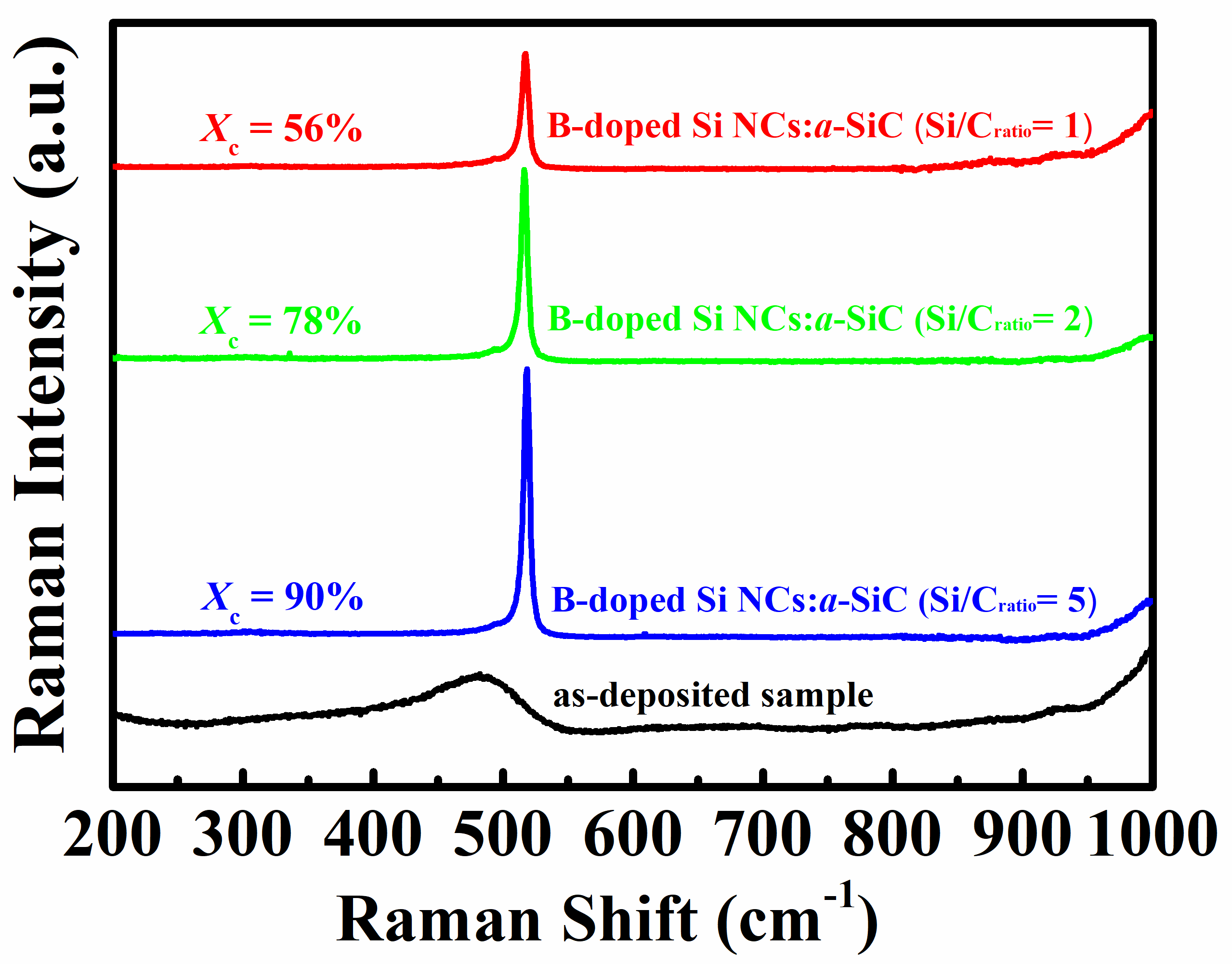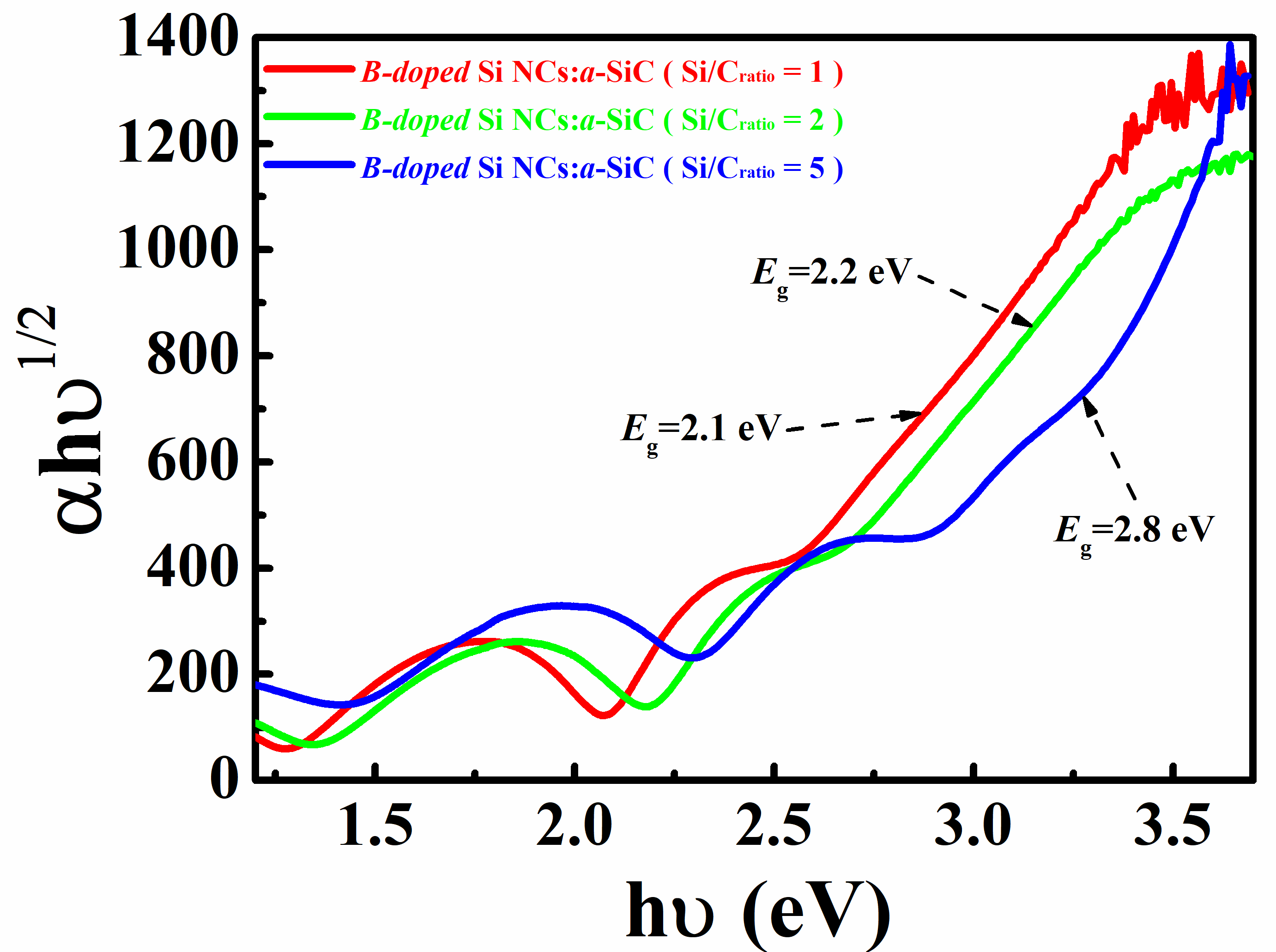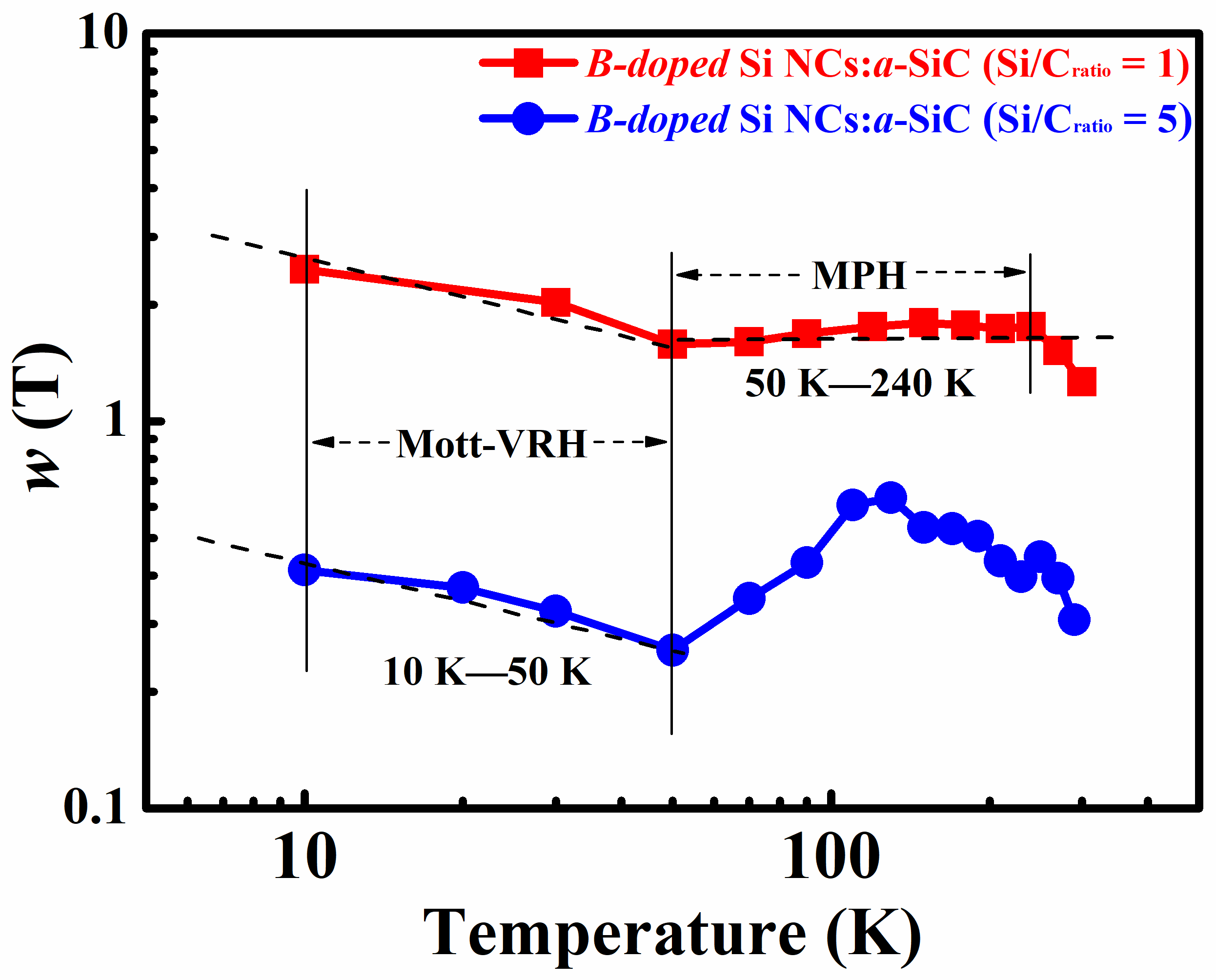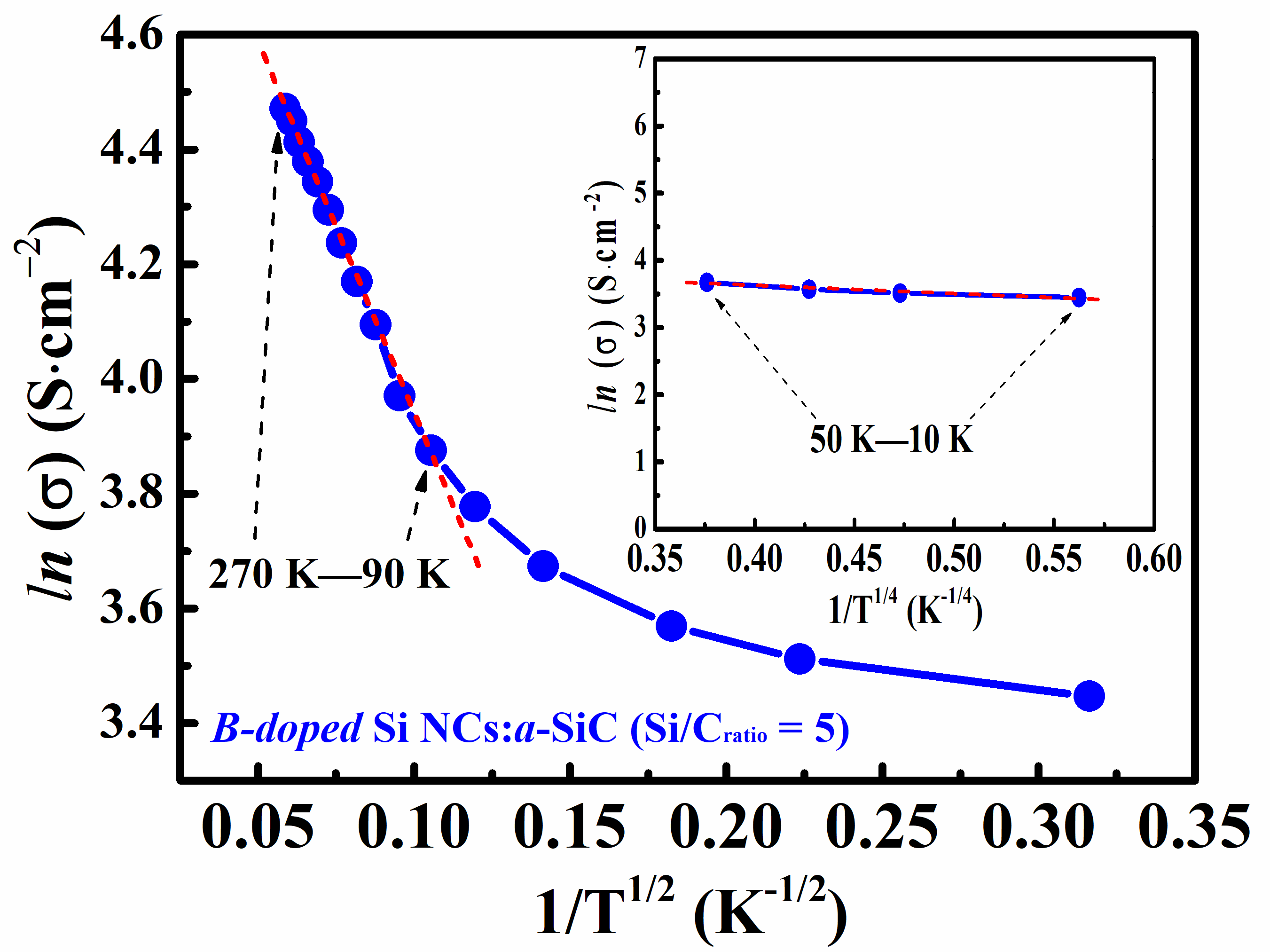Structures, Electronic Properties and Carrier Transport Mechanisms of Si Nano-Crystalline Embedded in the Amorphous SiC Films with Various Si/C Ratios
Abstract
:1. Introduction
2. Experiment
3. Results and Discussion
3.1. Nanostructure
3.2. Room Temperature Electronic Properties
3.3. Temperature-Dependent Conductivity
4. Conclusions
Author Contributions
Funding
Conflicts of Interest
References
- Molla, M.Z.; Zhigunov, D.; Noda, S.; Samukawa, S. Structural optimization and quantum size effect of Si-nanocrystals in SiC interlayer fabricated with bio-template. Mater. Res. Express 2019, 6, 065059. [Google Scholar] [CrossRef]
- Remes, Z.; Stuchlik, J.; Kupcik, J.; Mortet, V.; Taylor, A.; Ashcheulov, P.; Volodin, V.A. Electroluminescence of thin film pin diodes based on a-SiC: H with integrated Ge nanoparticles. Eur. Phys. J.-Appl. Phys. 2019, 88, 30302. [Google Scholar] [CrossRef]
- Heidarzadeh, H.; Rostami, A.; Dolatyari, M. Management of losses (thermalization transmission) in the Si-QDs inside 3C–SiC to design an ultra-high-efficiency solar cell. Mater. Sci. Semicond. Process. 2020, 109, 104936. [Google Scholar] [CrossRef]
- Charpentier, L.; Caliot, C.; Sans, J.L.; Bousquet, A. The impact of oxidation on the optical properties of Si-SiC materials. Ceram. Int. 2020, 46, 28536–28545. [Google Scholar] [CrossRef]
- Sultanov, A.; Nussupov, K.; Beisenkhanov, N. Investigation of SiC based antireflection coatings for Si solar cells by numerical FTDT simulations. Mater. Today Proc. 2021. [Google Scholar] [CrossRef]
- Cho, E.-C.; Green, M.A.; Conibeer, G.; Song, D.; Cho, Y.-H.; Scardera, G.; Huang, S.; Park, S.; Hao, X.J.; Huang, Y.; et al. Silicon quantum dots in a dielectric matrix for all-silicon tandem solar cells. Adv. Opto Electron. 2007, 69578. [Google Scholar] [CrossRef] [Green Version]
- Liu, X.; Shan, D.; Ji, Y.; Li, D.; Li, W.; Xu, J.; Chen, K. Improved device performance of Si-based heterojunction solar cells by using phosphorus doped Si nanocrystals embedded in SiC host matrix. AIP Adv. 2019, 9, 025213. [Google Scholar] [CrossRef]
- Cao, Y.; Zhu, P.; Li, D.; Zeng, X.; Shan, D. Size-Dependent and Enhanced Photovoltaic Performance of Solar Cells Based on Si Quantum Dots. Energies 2020, 13, 4845. [Google Scholar] [CrossRef]
- Xu, S.J.; Yu, M.B.; Rusli; Yoon, S.F.; Che, C.M. Time-resolved photoluminescence spectra of strong visible light-emitting SiC nanocrystalline films on Si deposited by electron-cyclotron-resonance chemical-vapor deposition. Appl. Phys. Lett. 2000, 76, 2550–2552. [Google Scholar] [CrossRef] [Green Version]
- Xu, X.; Cao, Y.Q.; Lu, P.; Xu, J.; Li, W.; Chen, K.J. Electroluminescence devices based on Si quantum dots/SiC multilayers embedded in PN junction. IEEE Photon. J. 2013, 6, 1–7. [Google Scholar] [CrossRef]
- Perani, M.; Brinkmann, N.; Hammud, A.; Cavalcoli, D.; Terheiden, B. Nanocrystal formation in silicon oxy-nitride films for photovoltaic applications: Optical and electrical properties. J. Phys. Chem. C 2015, 119, 13907–13914. [Google Scholar] [CrossRef]
- Song, C.; Rui, Y.; Wang, Q.; Xu, J.; Li, W.; Chen, K.; Zuo, Y.; Wang, Q. Structural and electronic properties of Si nanocrystals embedded in amorphous SiC matrix. J. Alloys Compd. 2011, 509, 3963–3966. [Google Scholar] [CrossRef]
- Fujii, M.; Inoue, Y.; Hayashi, S.; Yamamoto, K. Hopping conduction in SiO2 films containing C, Si, and Ge clusters. Appl. Phys. Lett. 1996, 68, 3749–3751. [Google Scholar] [CrossRef]
- Rafiq, M.A.; Tsuchiya, Y.; Mizuta, H.; Oda, S.; Uno, S.; Durrani, Z.A.K.; Milne, W.I. Charge injection and trapping in silicon nanocrystals. Appl. Phys. Lett. 2005, 87, 182101. [Google Scholar] [CrossRef] [Green Version]
- Rafiq, M.A.; Tsuchiya, Y.; Mizuta, H.; Oda, S.; Uno, S.; Durrani, Z.A.K.; Milne, W.I. Hopping conduction in size-controlled Si nanocrystals. J. Appl. Phys. 2006, 100, 014303. [Google Scholar] [CrossRef] [Green Version]
- Saripalli, S.; Sharma, P.; Reusswig, P.; Dalal, V. Transport properties of nanocrystalline silicon and silicon–germanium. J. Non Cryst. Solids 2008, 354, 2426–2429. [Google Scholar] [CrossRef] [Green Version]
- Wienkes, L.R.; Blackwell, C.; Kakalios, J. Electronic transport in doped mixed-phase hydrogenated amorphous/nanocrystalline silicon thin films. Appl. Phys. Lett. 2012, 100, 072105. [Google Scholar] [CrossRef]
- Shan, D.; Ji, Y.; Li, D.; Xu, J.; Qian, M.Q.; Xu, L.; Chen, K.J. Enhanced carrier mobility in Si nano-crystals via nanoscale phosphorus doping. Appl. Surf. Sci. 2017, 425, 492–496. [Google Scholar] [CrossRef]
- Ji, Y.; Shan, D.; Qian, M.Q.; Xu, J.; Li, W.; Chen, K.J. Formation of high conductive nano-crystalline silicon embedded in amorphous silicon-carbide films with large optical band gap. AIP Adv. 2016, 6, 105107. [Google Scholar] [CrossRef] [Green Version]
- Ouadfel, M.A.; Keffous, A.; Brighet, A.; Gabouze, N.; Hadjersi, T.; Cheriet, A.; Kechouane, M.; Boukezzata, A.; Boukennous, Y.; Belkacem, Y.; et al. Si-rich a-Si1−xCx thin films by dc magnetron co-sputtering of silicon and silicon carbide: Structural and optical properties. Appl. Surf. Sci. 2013, 265, 94–100. [Google Scholar] [CrossRef]
- Faraci, G.; Gibilisc, S.; Russo, P.; Pennisi, A.R.; Rosa, S.L. Modified Raman confinement model for Si nanocrystals. Phys. Rev. B 2006, 73, 033307. [Google Scholar] [CrossRef]
- Tsu, R.; Gonzalez-Hernandez, J.; Chao, S.S.; Lee, S.C.; Tanaka, K. Critical volume fraction of crystallinity for conductivity percolation in phosphorus-doped Si: F: H alloys. Appl. Phys. Lett. 1982, 40, 534–535. [Google Scholar] [CrossRef]
- Hao, X.J.; Cho, E.-C.; Flynn, C.; Shen, Y.; Conibeer, G.; Green, M.A. Effects of boron doping on the structural and optical properties of silicon nanocrystals in a silicon dioxide matrix. Nanotechnology 2008, 19, 424019. [Google Scholar] [CrossRef] [PubMed]
- Mirabella, S.; Agosta, R.; Franzò, G.; Crupi, I.; Miritello, M.; Savio, R.L.; Di Stefano, M.A.; Di Marco, S.; Simone, F.; Terrasi, A. Light absorption in silicon quantum dots embedded in silica. J. Appl. Phys. 2009, 106, 103505. [Google Scholar] [CrossRef]
- Shan, D.; Ji, Y.; Xu, J.; Lu, P.; Jiang, X.; Xu, J.; Chen, K. Microstructure and carrier transport behaviors of nanocrystalline silicon thin films annealed at various temperatures. Phys. Status Solidi A 2016, 213, 1675–1679. [Google Scholar] [CrossRef]
- Das, D.; Bhattacharya, K. Characterization of the Si:H network during transformation from amorphous to micro-and nanocrystalline structures. J. Appl. Phys. 2006, 100, 103701. [Google Scholar] [CrossRef]
- Shan, D.; Wang, H.; Tang, M.; Xu, J. Microscopic Understanding of the Carrier Transport Process in Ge Nanocrystals Films. J. Nanomater. 2018, 2018. [Google Scholar] [CrossRef] [PubMed] [Green Version]
- Seager, C.H.; Castner, T.G. Zero-bias resistance of grain boundaries in neutron transmutation doped polycrystalline silicon. J. Appl. Phys. 1978, 49, 3879–3889. [Google Scholar] [CrossRef]
- Hellmich, W.; Muller, G.; Krotz, G.; Derst, G.; Kalbitzer, S. Optical absorption and electronic transport in ion-implantation-doped polycrystalline SiC films. Appl. Phys. A 1995, 61, 193–201. [Google Scholar] [CrossRef]
- Seto, J.Y.W. The electrical properties of polycrystalline silicon films. J. Appl. Phys. 1975, 46, 5247–5254. [Google Scholar] [CrossRef]
- Myong, S.Y.; Lim, K.S.; Konagai, M. Effect of hydrogen dilution on carrier transport in hydrogenated boron-doped nanocrystalline silicon-silicon carbide alloys. Appl. Phys. Lett. 2006, 88, 103120. [Google Scholar] [CrossRef] [Green Version]
- Song, C.; Chen, G.; Xu, J.; Wang, T.; Sun, H.; Liu, Y.; Chen, K. Evaluation of microstructures and carrier transport behaviors during the transition process from amorphous to nanocrystalline silicon thin films. J. Appl. Phys. 2009, 105, 054901. [Google Scholar] [CrossRef]
- Das, D.; Sain, B. Electrical transport phenomena prevailing in undoped nc-Si/a-SiNx: H thin films prepared by inductively coupled plasma chemical vapor deposition. J. Appl. Phys. 2013, 114, 073708. [Google Scholar] [CrossRef]
- Zabrodskii, A.G. The Coulomb gap: The view of an experimenter. Philos. Mag. B 2001, 81, 1131–1151. [Google Scholar] [CrossRef]
- Mott, N.F. Conduction in non-crystalline materials: III. Localized states in a pseudogap and near extremities of conduction and valence bands. Philos. Mag. 1969, 19, 835–852. [Google Scholar] [CrossRef]
- Ambrosone, G.; Coscia, U.; Cassinese, A.; Barra, M.; Restello, S.; Rigato, V.; Ferrero, S. Low temperature electric transport properties in hydrogenated microcrystalline silicon films. Thin Solid Films 2007, 515, 7629–7633. [Google Scholar] [CrossRef]
- Qian, M.; Shan, D.; Ji, Y.; Li, D.; Xu, J.; Li, W.; Chen, K. Transition of carrier transport behaviors with temperature in phosphorus-doped Si nanocrystals/SiO2 multilayers. Nanoscale Res. Lett. 2016, 11, 1–7. [Google Scholar] [CrossRef] [Green Version]
- Brenot, R.; Vanderhaghen, R.; Drevillon, B.; Cabarrocas, P.R.I.; Rogel, R.; Mohammed-Brahim, T. Transport mechanisms in hydrogenated microcrystalline silicon. Thin Solid Films 2001, 383, 53–56. [Google Scholar] [CrossRef]
- Shimakawa, K.; Miyake, K. Hopping transport of localized π electrons in amorphous carbon films. Phys. Rev. B 1989, 39, 7578. [Google Scholar] [CrossRef] [Green Version]
- Shimakawa, K. Multiphonon hopping of electrons on defect clusters in amorphous germanium. Phys. Rev. B 1989, 39, 12933. [Google Scholar] [CrossRef]
- Fujii, M.; Mamezaki, O.; Hayashi, S.; Yamamoto, K. Current transport properties of SiO2 films containing Ge nanocrystals. J. Appl. Phys. 1998, 83, 1507–1512. [Google Scholar] [CrossRef]
- Zhou, X.; Usami, K.; Rafiq, M.A.; Tsuchiya, Y.; Mizuta, H.; Oda, S. Influence of nanocrystal size on the transport properties of Si nanocrystals. J. Appl. Phys. 2008, 104, 024518. [Google Scholar] [CrossRef] [Green Version]
- Šimánek, E. The temperature dependence of the electrical resistivity of granular metals. Solid State Commun. 1981, 40, 1021–1023. [Google Scholar] [CrossRef]






| Sample | Hall Mobility | Carrier Concentration | Dark Conductivity |
|---|---|---|---|
| B-doped Si NCs:a-SiC film (Si:Cratio = 5) | 7.2 cm2/Vs | 4.6 × 1019 cm−3 | 87.5 S∙cm−1 |
| B-doped Si NCs:a-SiC film (Si:Cratio = 2) | 4.8 cm2/Vs | 1.9 × 1018 cm−3 | 1.46 S∙cm−1 |
| B-doped Si NCs:a-SiC film (Si:Cratio = 1) | 1.7 cm2/Vs | 8.7 × 1016 cm−3 | 0.023 S∙cm−1 |
Publisher’s Note: MDPI stays neutral with regard to jurisdictional claims in published maps and institutional affiliations. |
© 2021 by the authors. Licensee MDPI, Basel, Switzerland. This article is an open access article distributed under the terms and conditions of the Creative Commons Attribution (CC BY) license (https://creativecommons.org/licenses/by/4.0/).
Share and Cite
Shan, D.; Sun, D.; Tang, M.; Yang, R.; Kang, G.; Tao, T.; Cao, Y. Structures, Electronic Properties and Carrier Transport Mechanisms of Si Nano-Crystalline Embedded in the Amorphous SiC Films with Various Si/C Ratios. Nanomaterials 2021, 11, 2678. https://doi.org/10.3390/nano11102678
Shan D, Sun D, Tang M, Yang R, Kang G, Tao T, Cao Y. Structures, Electronic Properties and Carrier Transport Mechanisms of Si Nano-Crystalline Embedded in the Amorphous SiC Films with Various Si/C Ratios. Nanomaterials. 2021; 11(10):2678. https://doi.org/10.3390/nano11102678
Chicago/Turabian StyleShan, Dan, Daoyuan Sun, Mingjun Tang, Ruihong Yang, Guangzhen Kang, Tao Tao, and Yunqing Cao. 2021. "Structures, Electronic Properties and Carrier Transport Mechanisms of Si Nano-Crystalline Embedded in the Amorphous SiC Films with Various Si/C Ratios" Nanomaterials 11, no. 10: 2678. https://doi.org/10.3390/nano11102678






